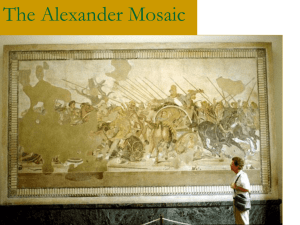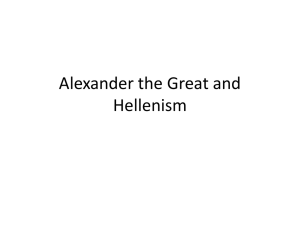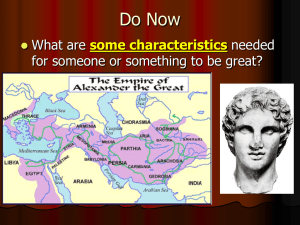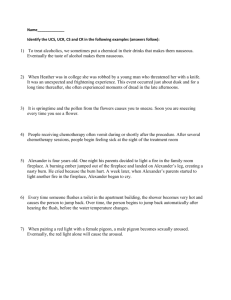Nano- History
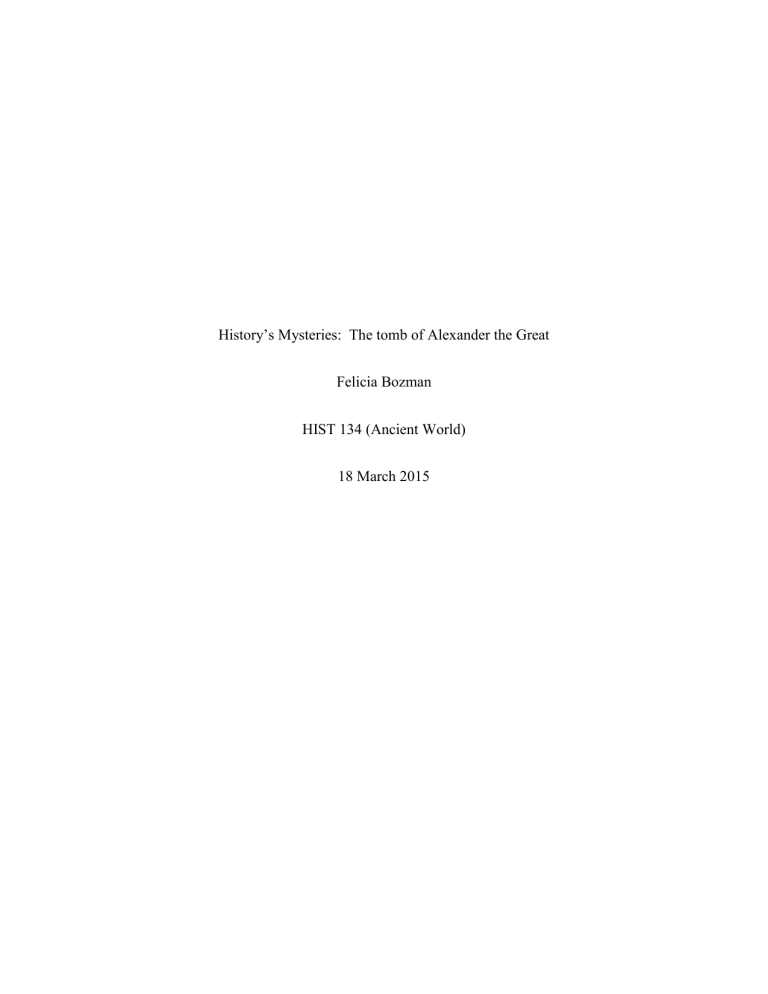
History’s Mysteries: The tomb of Alexander the Great
Felicia Bozman
HIST 134 (Ancient World)
18 March 2015
Bozman 1
Alexander the Great was a King of the Ancient Greek kingdom of Macedon. He is well known for his many military successes and even to this day is considered one of the most influential rulers ever to be seen. Alexander lived a courageous and honorable life and still touches the lives of many people today. The death of the great leader to this day remains unknown. What is known however, is the great influence that Alexander the Great portrayed onto his people. He was honored and worshiped by many. Alexander was seen with such great importance that his tomb was worshiped as a religious icon by some, moved from place to place according to legends, and still today remains a mystery that is working to be uncovered.
Around 323 BC Alexander the Great had conquered most of the known world.
He was a very powerful man with a very powerful army and empire backing him. No one would have expected such a sudden death from such a great man. Alexander was in Babylon when he died. He was resting and taking an opportunity to celebrate all of his military accomplishments for a couple days before planning new endeavors for the empire. Alexander spent a long day drinking and having dinner with some of his closest friends. Into the night Alexander was attacked by a heavy fever
1
in the form of some type of disease, bacteria, virus, or as some people believed, a poison (O’Brien 214). The exact diagnostic of his death has not yet been proven, but it was powerful enough to bring the strong ruler to his final downfall.
The death of the honorable King shocked many people around the world. To treat
Alexander with one last action of respect, he was placed in a beautiful coffin of hammered gold that was fitted to his body perfectly
2
. The coffin was thought to help preserve and protect the
King as he continued to inspire his people even after he was dead. The coffin was a sign of high status, wealth, love, and honor. Alexander the Great’s people viewed him in such a positive
Bozman 2 way, and their respect for the man is displayed even further through the rich and rare materials used to condemn the life of their King.
When Alexander the Great died in Babylon, his body became the possession of negotiations between his generals. These general included Perdiccas, Ptolemy I Soter, and
Seleucus I Nicator. The first decided resting location for the tomb was back in Aegae, the home and center of Alexander the Great’s reign. During this transition however the tomb was hijacked by Ptolemy I Soter. The tomb was then transferred and buried in Memphis, the center of
Alexander’s governmental influence on Egypt. After hearing word of this change, some of the other generals, including and focusing on Seleucus I Nicator, were sent to a serapeum to ask the oracle if the tomb of their King should be moved to Alexandria. This was the city founded, created, and named by Alexander the Great himself. The oracle replied positively, so the tomb was recovered and moved yet again to have another burial (Bury 820).
In the Egyptian city of Alexandria, a cemetery of rich burials was located. This place is now commonly referred to as The Valley of Golden Mummies. It was built like a chapel and represented high honor and status by the Mahometans. It was discovered in June 1999 and was measured to be two square miles of tomb filled cemetery. The cemetery is estimated to hold near ten thousand mummies (El-Gindi 188). Here lied Alexander the Great himself and many other different types of people from many different parts of the world. When the cemetery was first constructed, it was designed for the wealthy and powerful people of the world, however
Alexander the Great’s burial here changed that idea. The variety and diversity of people buried in this cemetery raises the question of why.
Bozman 3
The Valley of the Golden Mummies was originally used as a place of worship. Many people around the time of 600 AD believed Alexander the Great to be their God. He claimed himself to be the son of Zeus. Alexander had the status of a demi-god his whole life and linked his blood line straight to other hero Gods (Fuller 268). He modeled his behavior after these Gods and convinced his people it was the truth. His burial here was very influential to the religious beliefs of the area because the people made it custom to sacrifice their offerings, to say prayers, and to conduct other religious activity near the tomb of Alexander (El- Gindi 188).
The tomb and burial site at one time was covered with generous offerings and gifts to their lord Alexander. His body was kept in secret for worship and as the people died they wished to be laid down with their savior and King that they worshiped so heavily
3
. This is what separated the original distinction of The Valley of the Golden Mummies and allowed normal people with middle or low social status to be buried here because it was a part of their firm religious beliefs.
As time passed on, the religious ideals and people of great power and status began to change and the focus shifted away from Alexander the Great. As time passed The Valley of
Golden Mummies became deserted and nearly forgotten. Even to this day the exact location of the body of Alexander the Great cannot be confirmed. There are many legends and beliefs that state where the body lies and what the path of the tomb was, but no evidence can support these claims at this time. The tomb of Alexander the Great will forever serve as a mystery and place of incredible interest and historical significance. Even after twenty two centuries, Alexander the
Great still possesses irresistible power over people.
Bozman 4
Endnotes
1. For a second reference to the feverish symptoms cross examine the information provided in A History of Greece to the Death of Alexander the Great specifically page 821.
2. For more information about how Alexander the Great’s body was preserved and others in the same cemetery closely read from “The valley of the golden mummies,” and observe the picture on page 188 as it was similar to the gilded manner used upon Alexander the Great.
3. For more information on the connection between Alexander the Great and his people read from The generalship of Alexander the Great specifically chapter 9; Alexander’s
Statesmanship.
Bozman 5
Annotated Bibliography
Bury, John Bagnell. A History of Greece to the Death of Alexander the Great . Macmillan and
Company, limited, 1906.
This book by John Bagnell Bury proved to be a useful and scholarly addition to my research. Bury was a well-known historian and is credited with many other works that are considered credible and scholarly. This book gave a great over view of the entire life of Alexander the Great that lead up to his death and further on. It provided background knowledge that allowed me to write this paper with some intelligence on the subject of
Alexander’s tomb.
El- Gindi, Sayed. “The valley of the golden mummies.” Neurosurgery 49.1 (2001): 188-191.
This article was very helpful in writing my research paper. This source is considered credible and scholarly because I found the article on Google Scholar and it was written by a Professor at the School of Medicine at Yale University. This article gave me specific information regarding The Valley of the Golden Mummies that I mention in my research. The article also proved geographic information that I was able to cross examine with some of my other sources to ensure that the exact locations in my research are correctly labeled.
Fuller, John Frederick Charles. The generalship of Alexander the Great . Da Capo Press, 2004.
This book was useful to my research because it provided a credible source about the kind of man that Alexander the Great truly was. The author, Fuller, was a military historian and strategist which proves him credible to critique Alexander the Great and his decisions
Bozman 6 as a powerful ruler. This book went into great detail about the way Alexander the Great treated his people and the way they perceived him as their King. This information allowed me to write about the impact that Alexander the Great’s death had on his people.
O’Brien, John Maxwell. Alexander the Great: the invisible enemy: a biography . Routledge,
2003.
This book was helpful to conducting my research. It is considered a scholarly and credible source due to the fact that it was written by John Maxwell O’Brien, a Professor of History at Queens College of the City University of New York and the facts can be cross checked and verified by some of my other sources listed. This source provided a detailed explanation of the death of Alexander the Great and some mysteries behind the situation. I was able to incorporate this information into my research as it supported the relevance of Alexander’s tomb and the events that led to his death.

